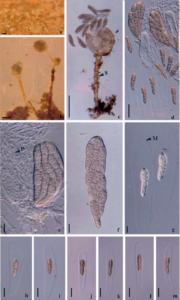Aliquandostipite manochii Sri-indr., Boonyuen, Suetrong, K.L. Pang & E.B.G. Jones.
Index Fungorum number: IF550752, Facesoffungi number: FoF00493; Fig. 1
Etymology– “manochii” – in honour to Prof. Dr. Leka Manoch as her family name, a Thai distinguished mycologist and a co-chair, IMC10 steering committee, The 10th International Mycological Congress (IMC 2014).
Holotype– BBH 38816
Saprobic on dead wood. Sexual morph Ascomata 250 – 310 high ×290–320μm wide, globose to subglobose, gregarious, immersed, superficial with stalk (up to 500 μm long and 25 – 40 μm wide) or erumpent, shedding wood particles and becoming superficial with base remaining immersed, dark brown to black, coriaceous, ostiolate. Stalk septate 2.5 – 7.5 μm wide. Peridium Undetermined. Hamathecium comprising ca 2.5 – 7.5 μm diam., hypha-like, filamentous, hyaline, septate, pseudoparaphyses, unbranched between the asci, branching and anastomosing above. Asci 125 – 200 × 20 – 55 μm, 8 – spored, obclavate, short pedicellate, bitunicate, fissitunicate, with an ocular chamber and a faint ring. Ascospores 50 – 80 × 10 – 17.5 μm, brown, biseriate, 1-septate, light brown, guttulate, ellipsoid–fusiform, minutely verruculose, constricted at the septum, surrounded by a wide mucilaginous sheath. Asexual morph Undetermined.
Culture characters – Ascospores did not germinate on media.
Material examined – THAILAND, Nakhon Ratchasima, Khao Yai National Park, Wang Champi Waterfall (Latitude: 14.7117, Longitude: 101.4117, 757 meters above sea level), on submerged wood of an unidentified tree, 3 April 2003, V. Sri-indrasutdhi, N. Boonyuen & S. Sivichai, BBH 38816 (holotype).
Notes – A genus in Aliquandostipitaceae (Jahnulales, Dothideomycetes) based on morphological observations as the species did not germinate on standard media. Our new species ismorphologically similar to species of Jahnula; however, morphological features of A. manochii agree with species of Aliquandostipite as proposed by Inderbitzin et al. (2001) and Suetrong et al. (2011). It is characterized by the dimorphic ascomata, with a superficial stalk, and the arrangement of spores in the asci, and ascospores with a mucilaginous sheath or pad. Morphologically A. manochii is most similar to A. khaoyaiensis in having ascospores with a broad gelatinous sheath, but differs in having a branched and anastomosing hamathecium above of the asci, lacking arcicular crystals within the spores, and in ascospore size (Raja et al. 2005; Raja and Shearer 2007).

Fig. 1 Aliquandostipite manochii (holotype). a-c Immersed and superficial ascomata with septate stalk marked by arrow (S) in the substratum d-f Asci which are 8 – spored, obclavate, pedicellate, bitunicate, fissitunicate, with an ocular chamber and a faint ring with pseudoparaphyses marked by arrow (P) g-m Ascospores with a broad mucilaginous sheath marked by arrow (M), brown, biseriate, 1 – septate and ellipsoid-fusiform. Scale bars a = 200 μm, b – c = 100 μm, d = 50 μm, e – f = 20 μm, g = 15 μm, h – m = 30 μm.
